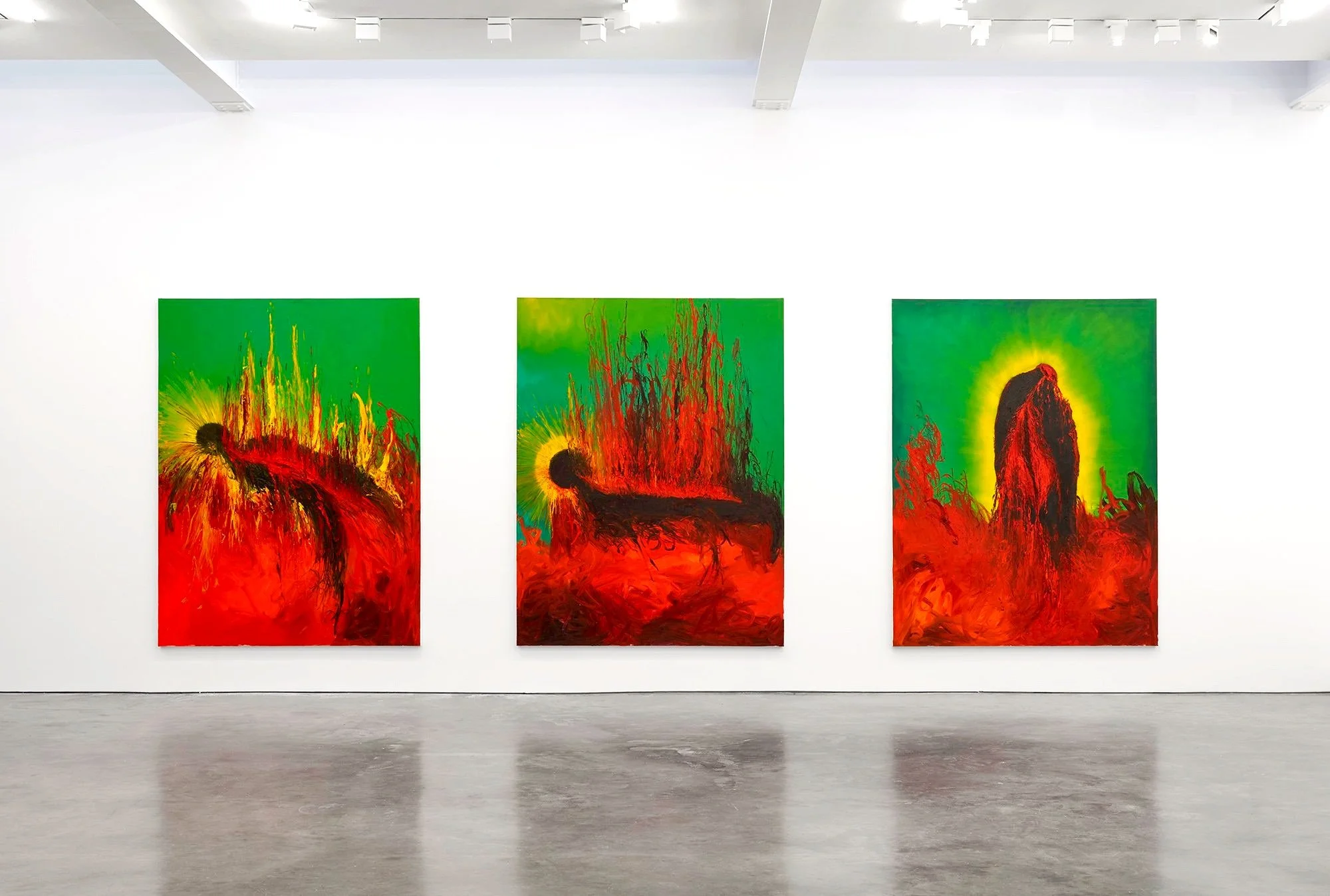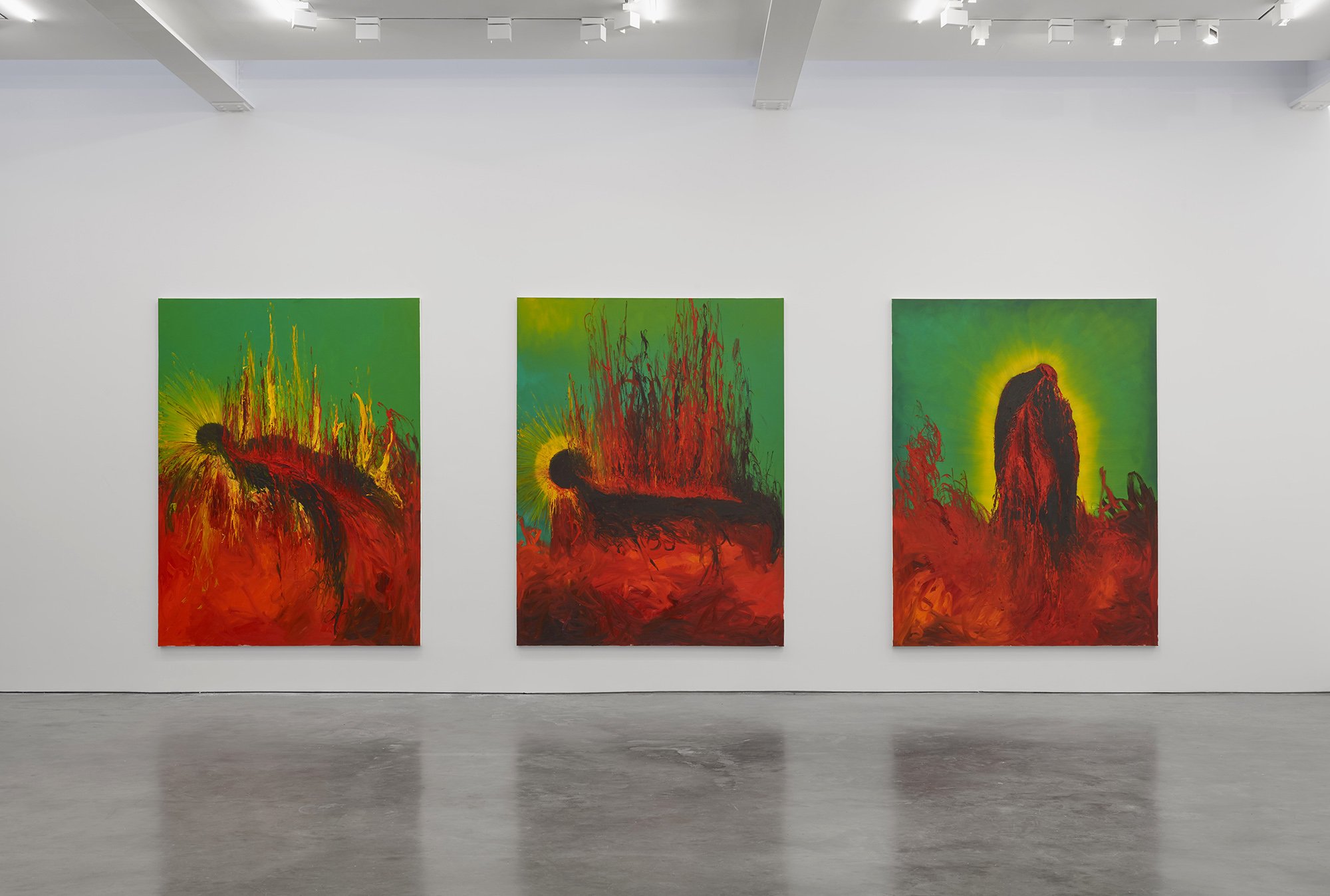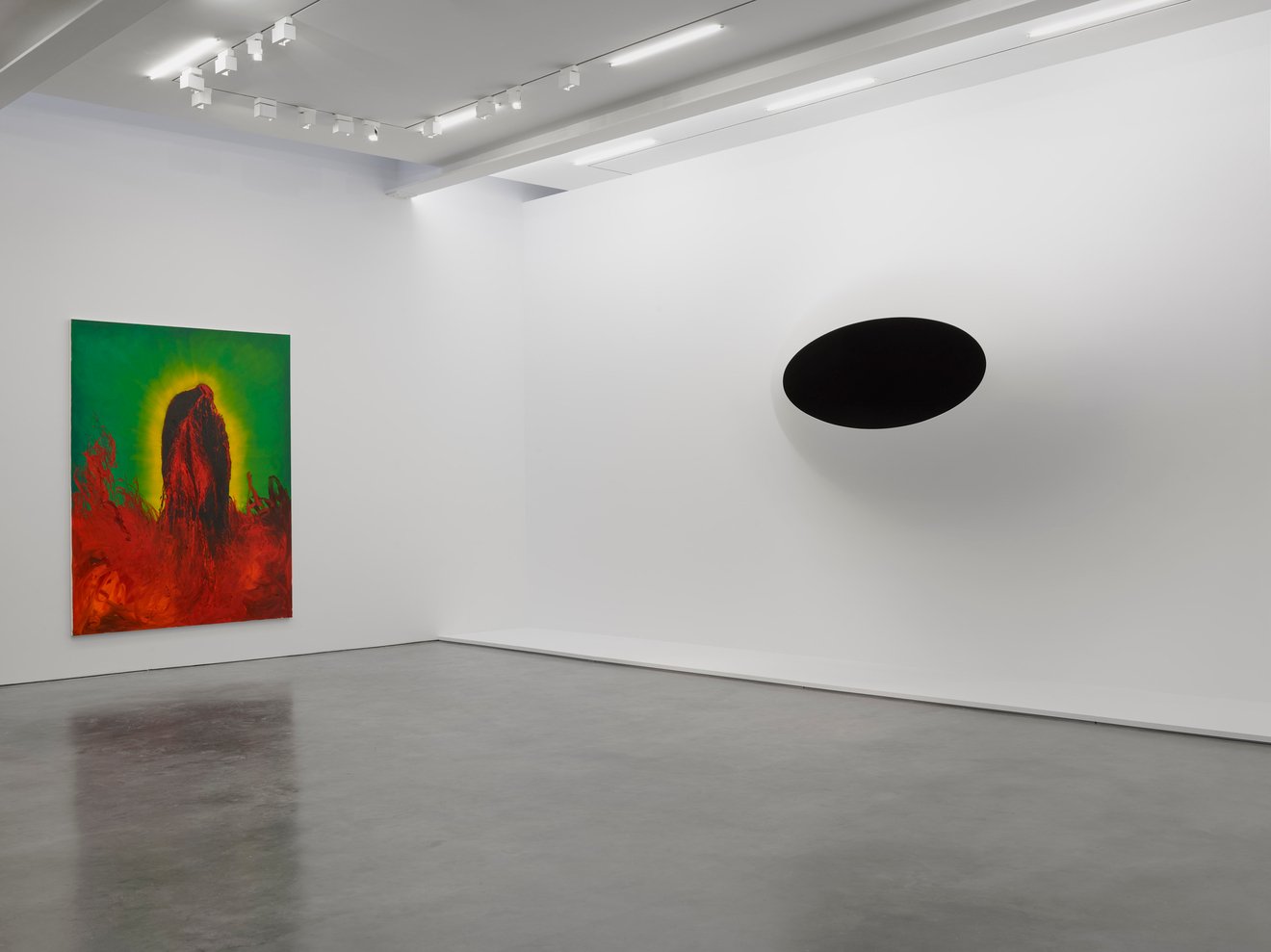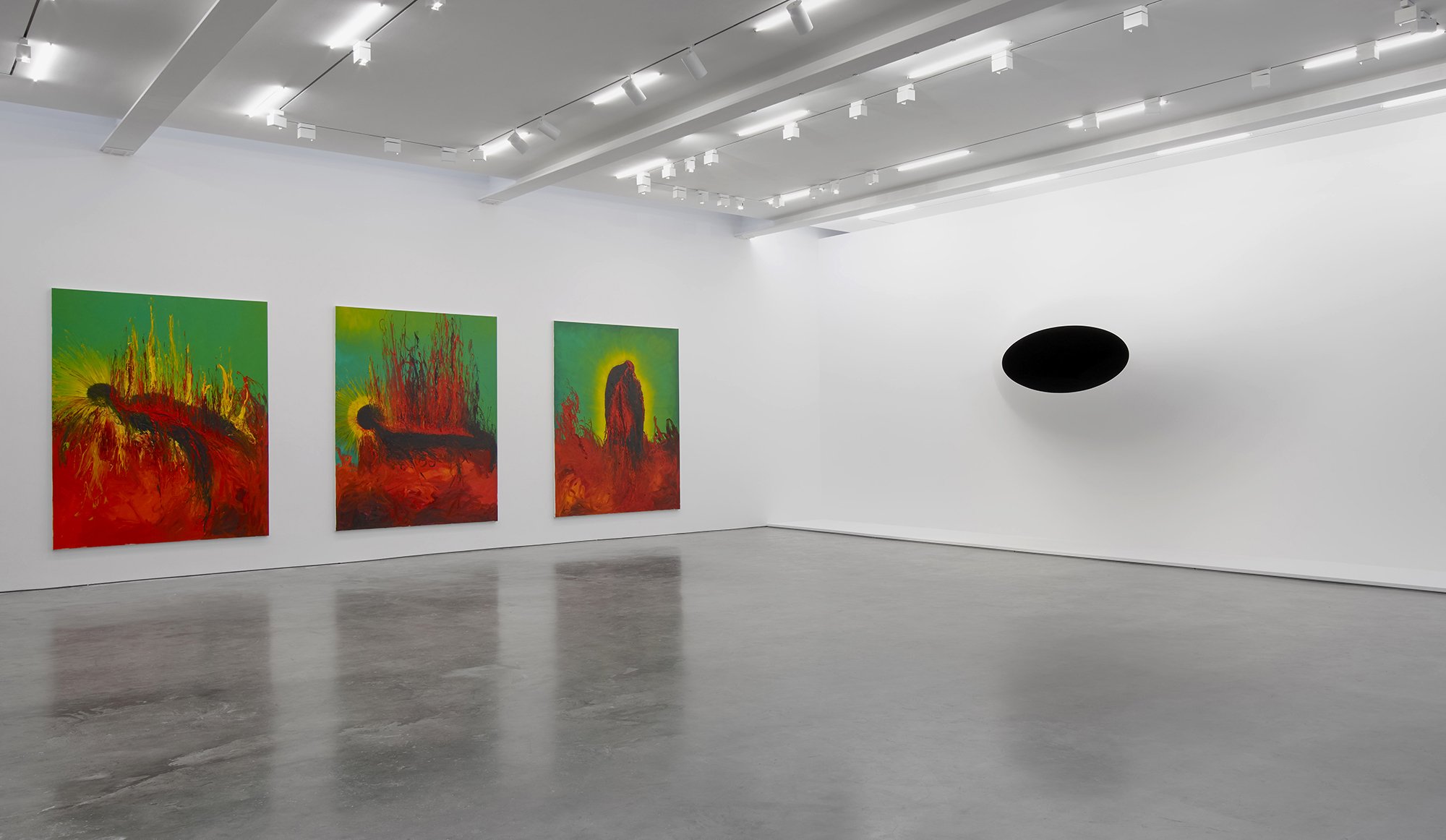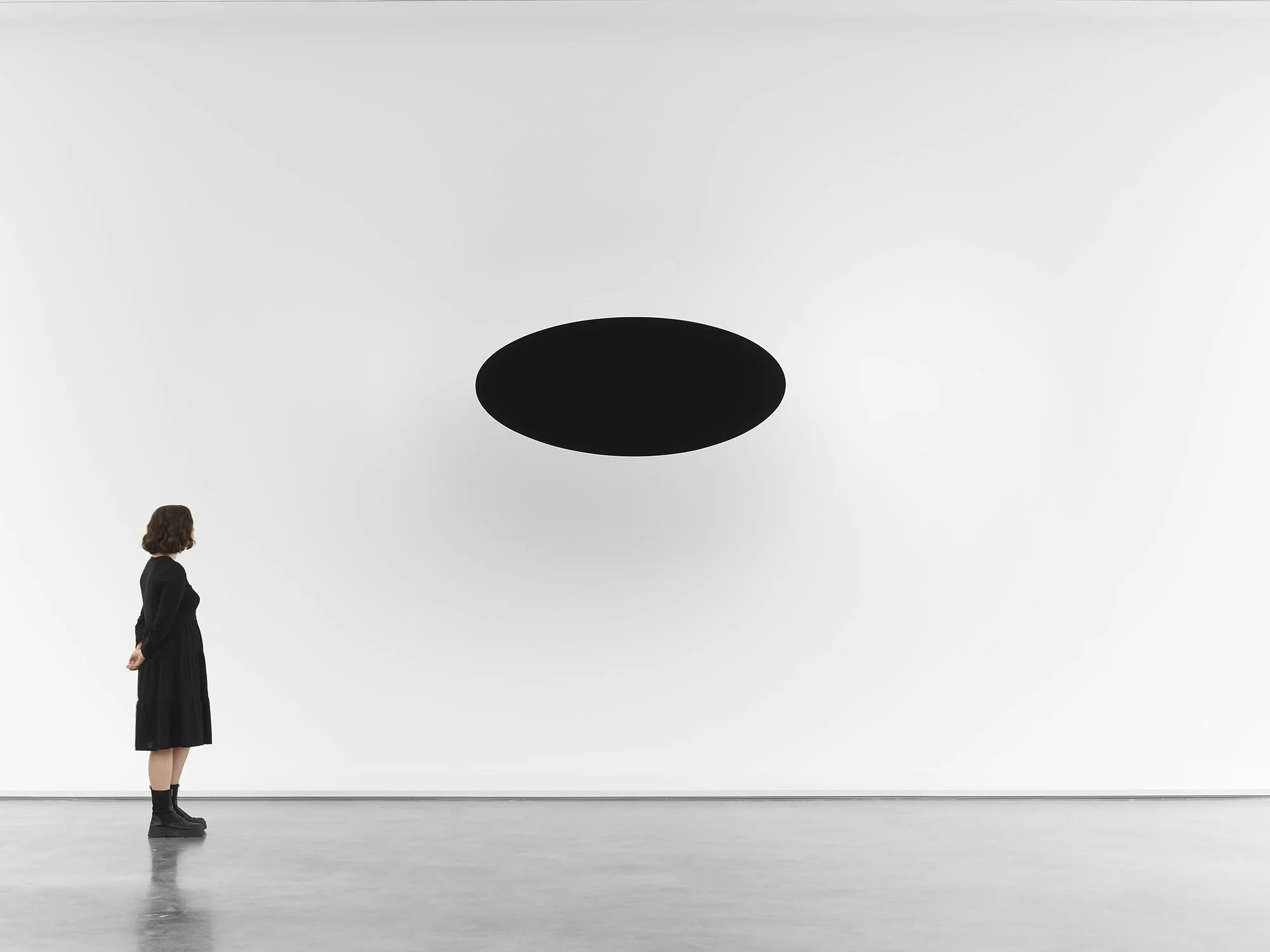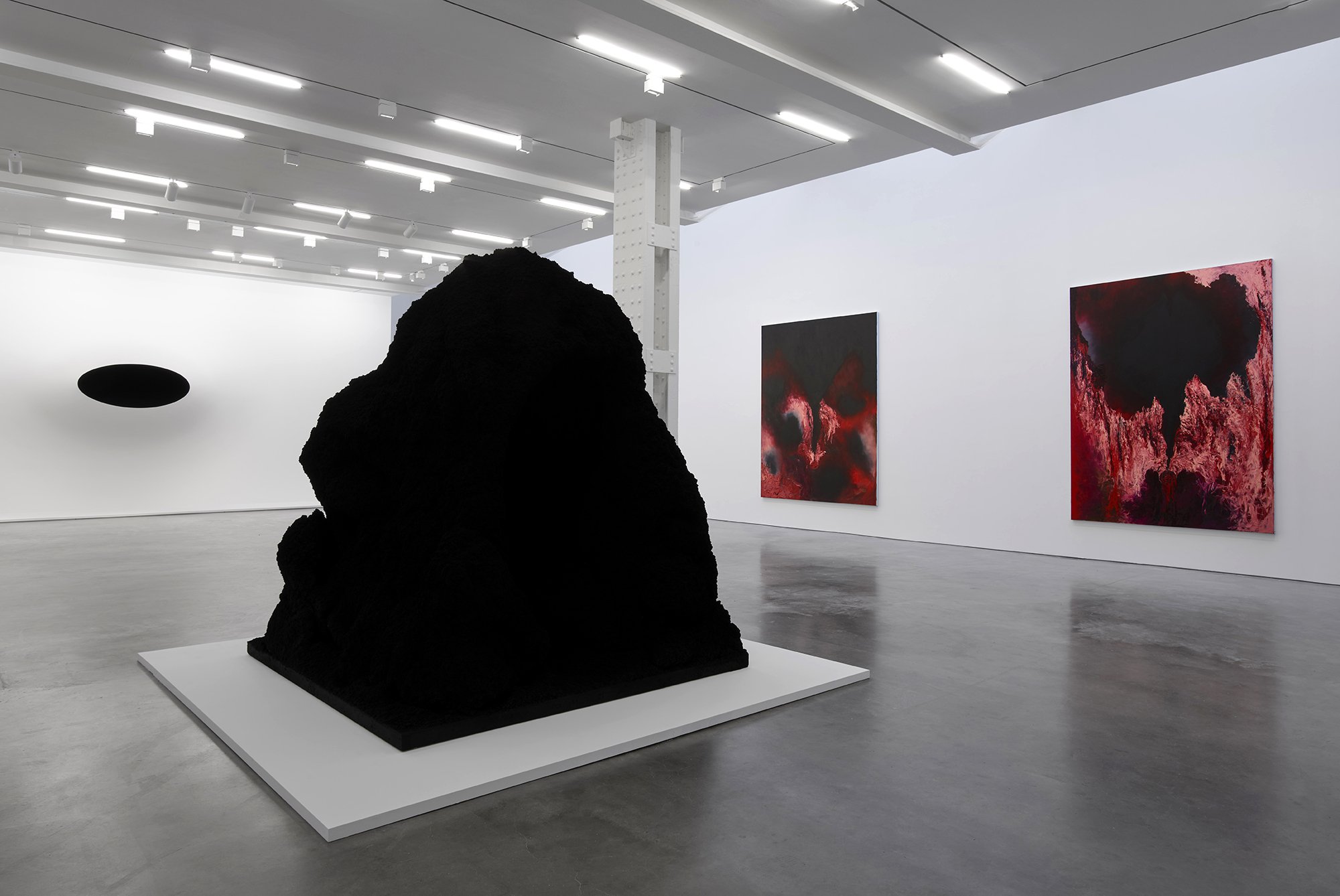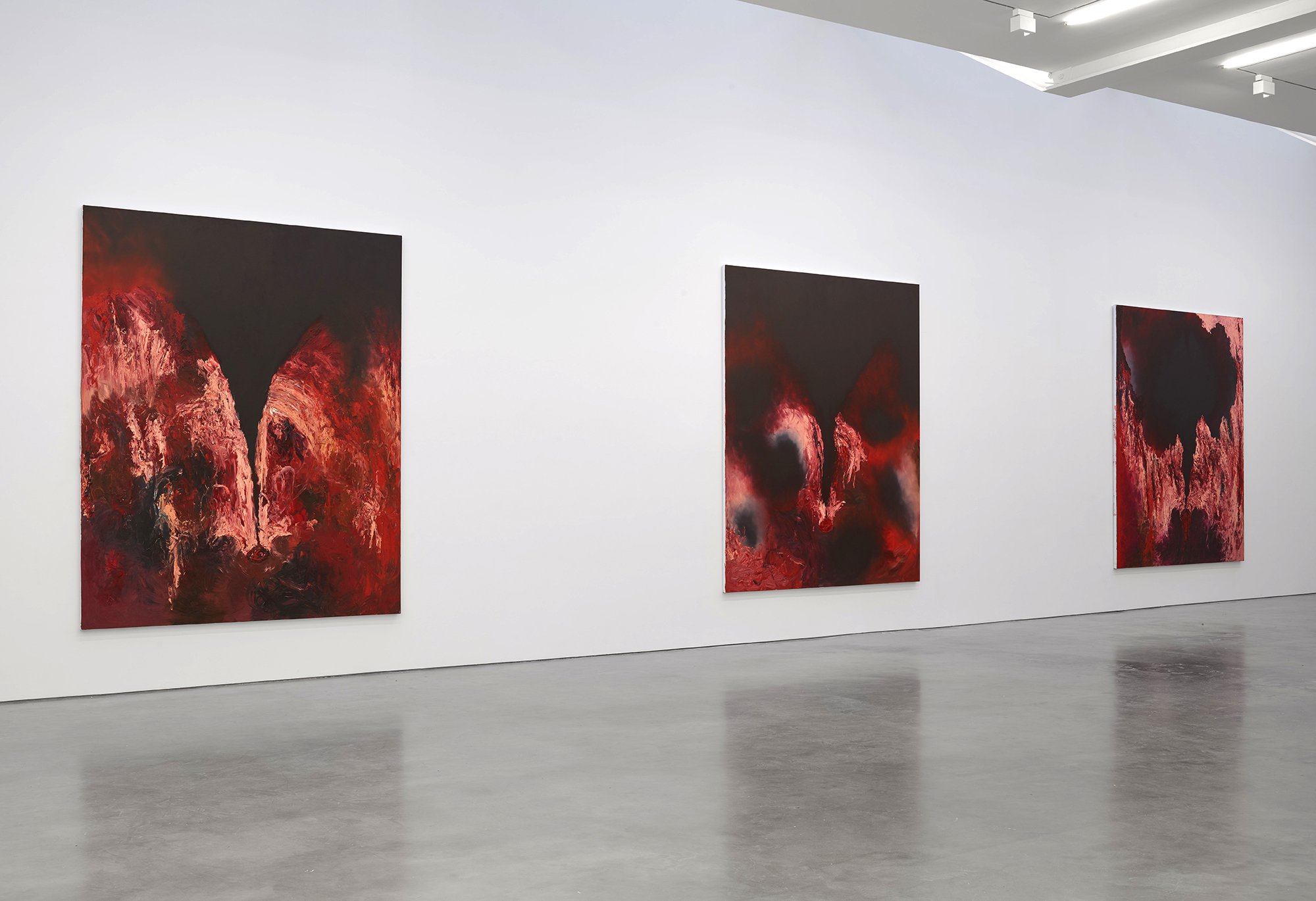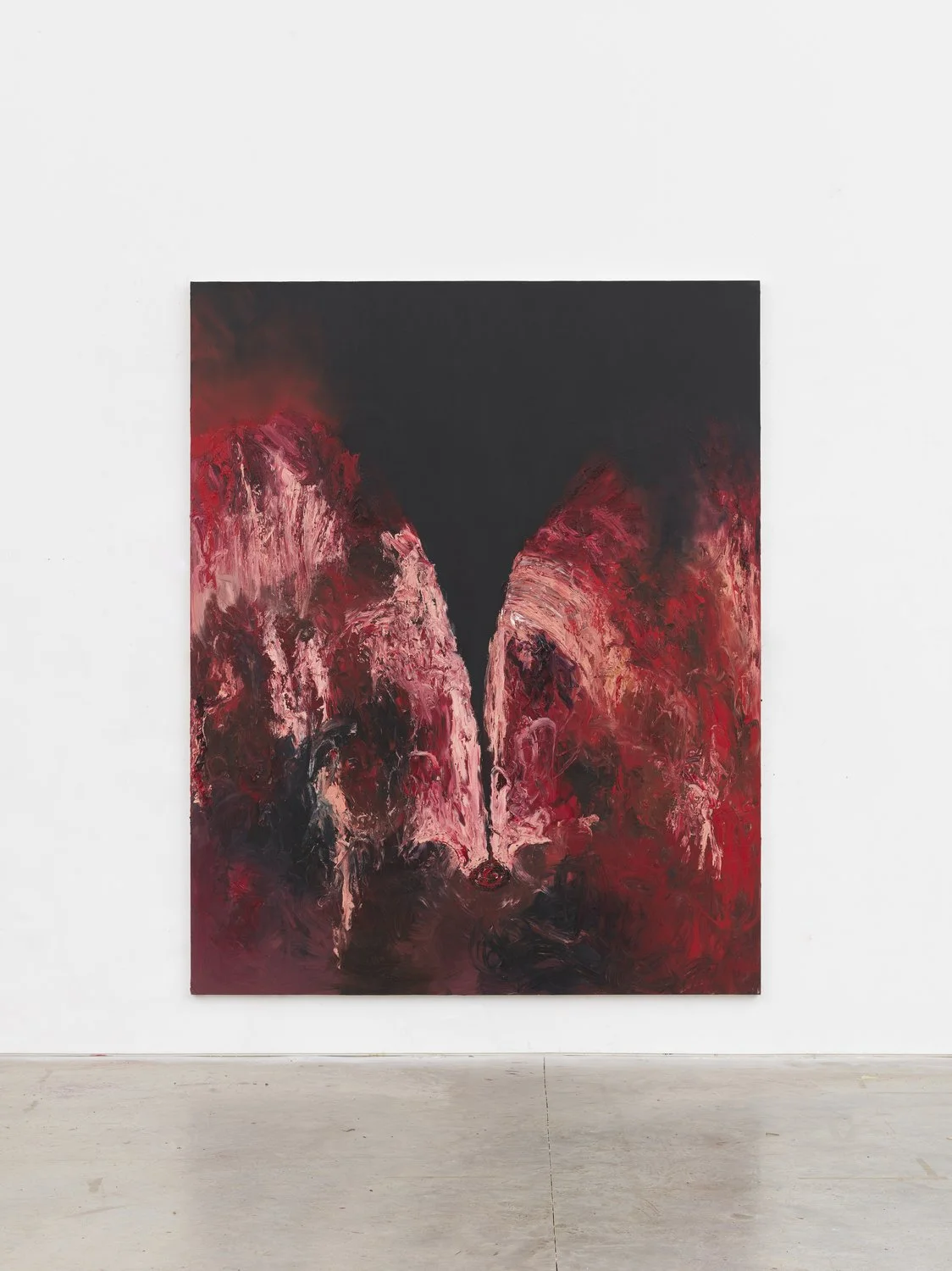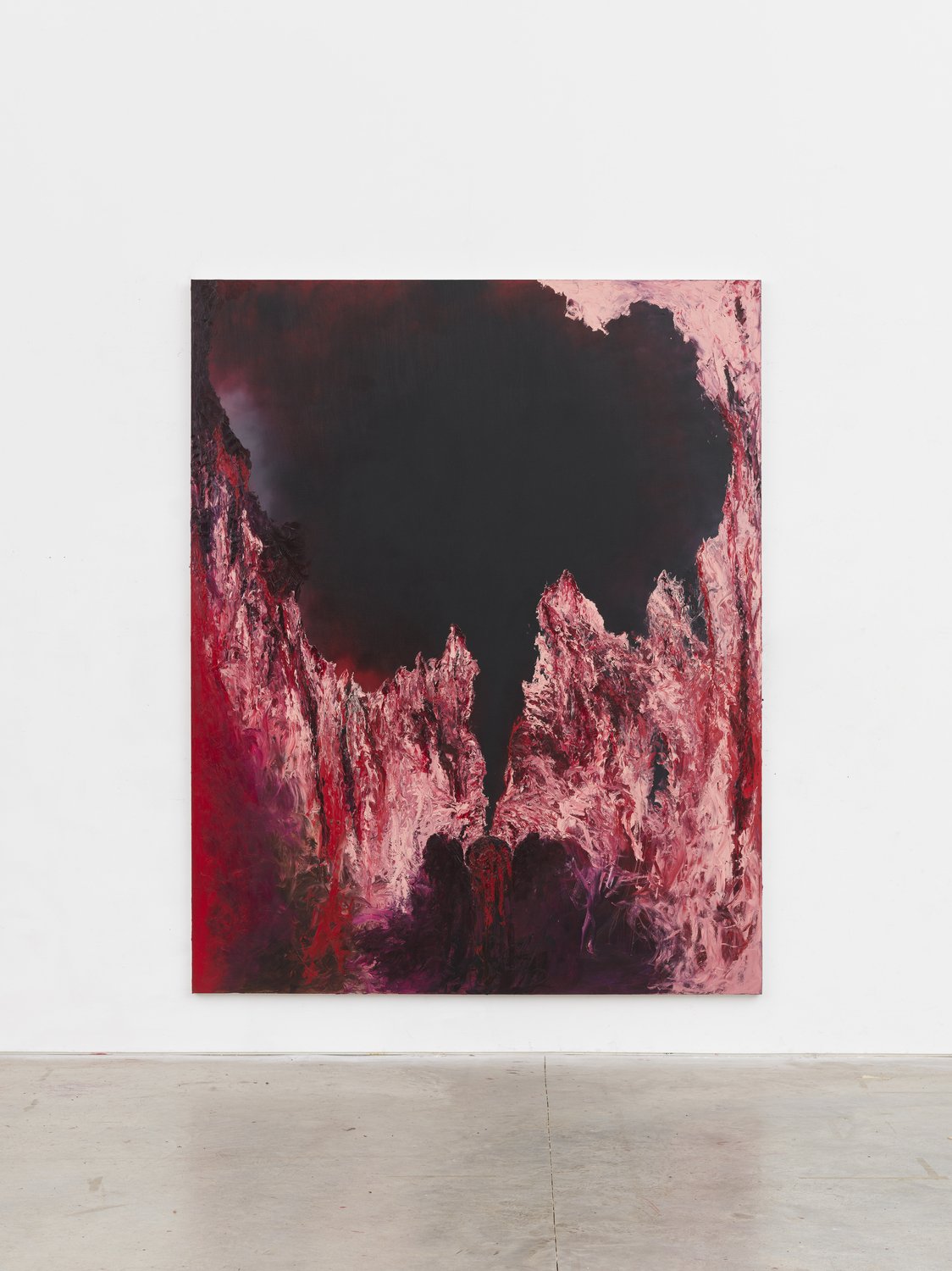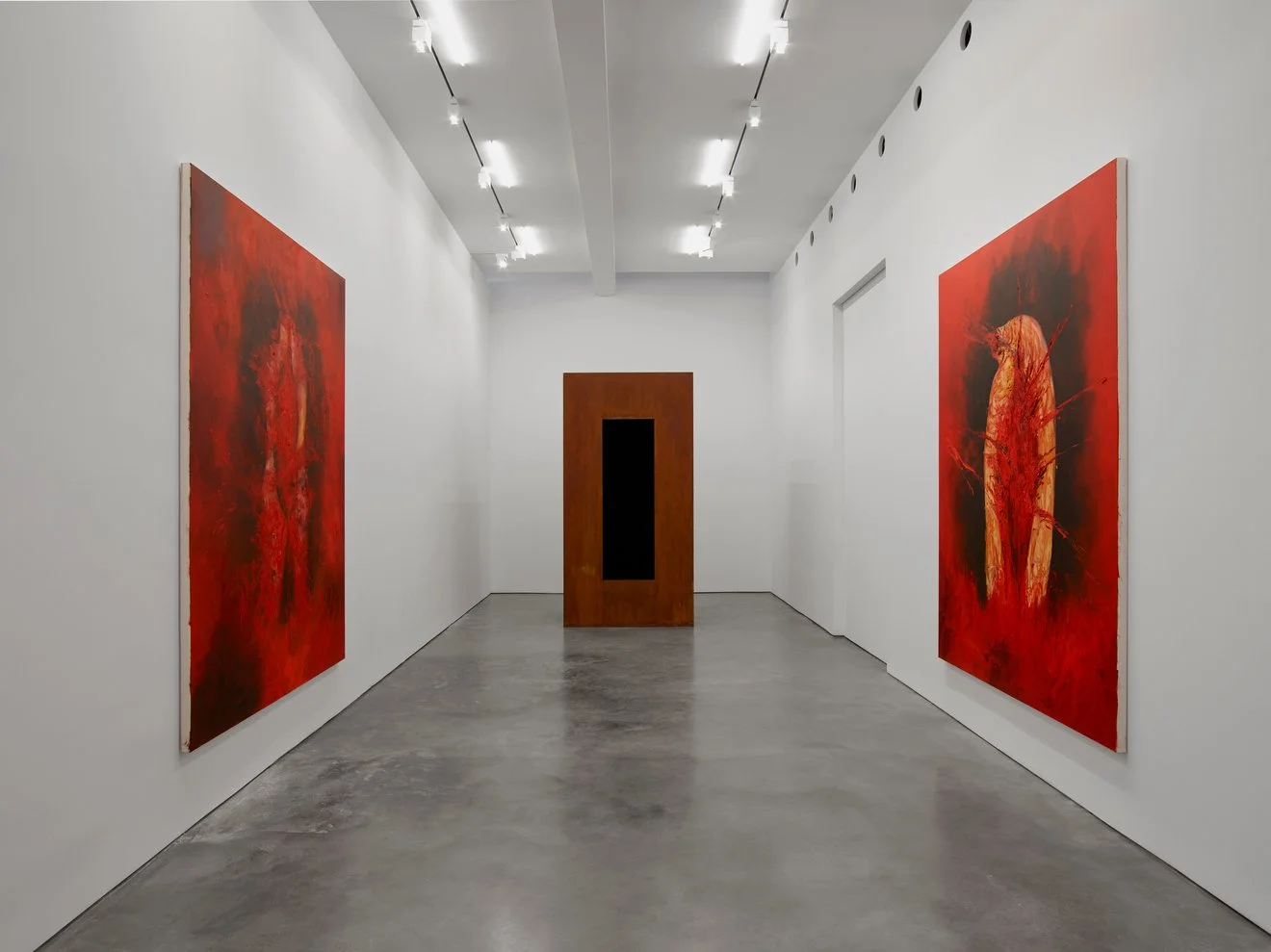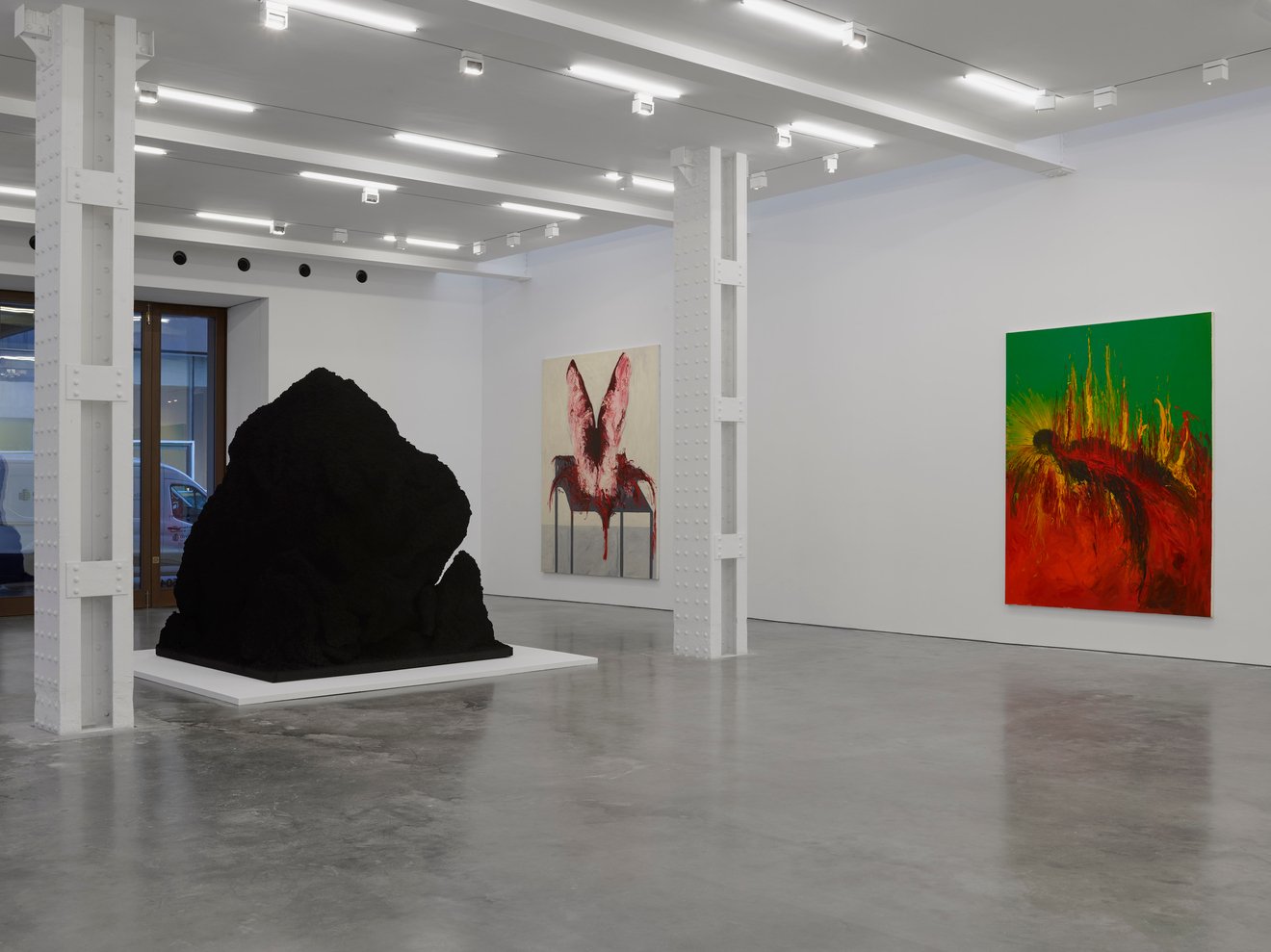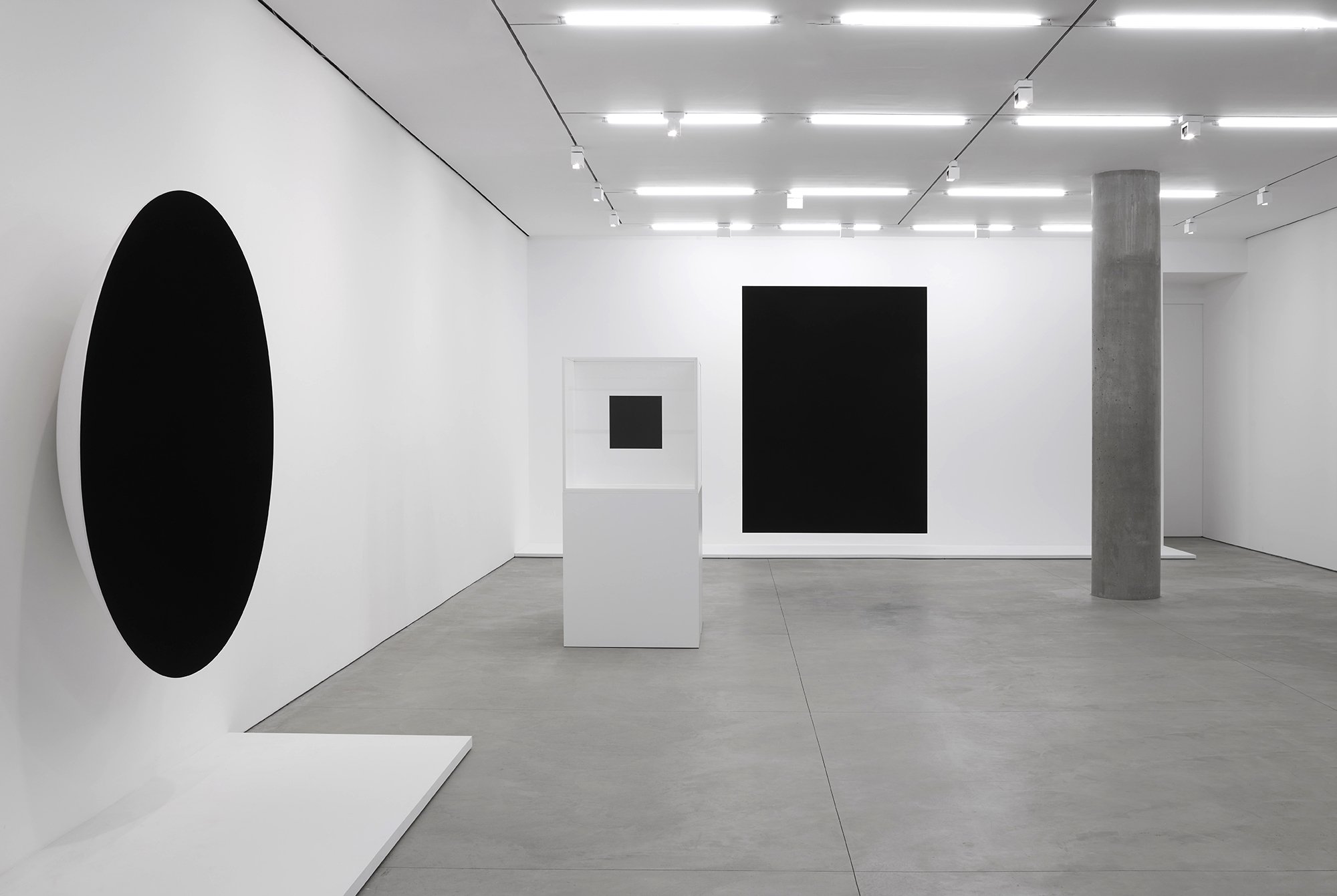Anish Kapoor:
(IN)VISIBLE
Lisson Gallery New York
November 2 through December 22, 2023
Exhibition Review by Raphy Sarkissian
Nothingness carries being in its heart.
—Jean-Paul Sartre (1)
Anish Kapoor, Untitled, 2023. Mixed media and paint, 189 by 236.25 by 59 inches. On view at 504 Lisson Gallery. © Anish Kapoor, courtesy of the artist and Lisson Gallery.
Too elegant, too tactical, too perfect: such were the characteristics of Anish Kapoor’s hyperreflective sculptures of the unforgettable and exuberant exhibition held at Lisson Gallery in New York some four years ago. With immaculately polished surfaces, those optical devices, whether immense or human in scale, appeared as matchless catalysts for arresting phenomenological inquiries into the parameters of vision and the paradoxes of visual representation. Eyesight as an aporia manifested itself unambiguously. The viewer’s mobility contributed to the cinematic traits of the sculptural mirrors that appeared to be floating on the ground or had crawled up the walls. The opulent designs of those rational apparatuses were counteracted by the formlessness of irrational reflections. Poetry became visible, as the epic form became experiential. Proceeding to stare at our continual transfigurations, our imagery transpired, became inverted, then dissipated. The sybaritic contest between abstraction and semblance ran parallel to the dialogue between our bodies and the world around us. Order that defined forms and surfaces uncannily adumbrated our visceral organicity. Through our replication we became dilated and metamorphosed into Brunelleschi’s clouds. Seduced by narcissism, engulfed in sheens, and deluged with the pleasures of spectatorship, the search for an authorial gesture was extraneous.
Anish Kapoor, paintings from the group Dead Mother in Exile, 2022 (left) and Untitled, 2023 (right) at 504 Lisson Gallery. © Anish Kapoor, courtesy of the artist and Lisson Gallery.
Astoundingly, impetuous gestural marks, agitated strokes, unbridled impasto, and luminous coloration prevail in the ten ultra-baroque paintings in the Lisson Gallery’s current installation at 504 West 24 Street. Exhibited alongside two architecturally fashioned untitled works and the formless Grave (2019), the show encompasses pictorial representations alongside sculptural works. Running parallel to Edmund Husserl’s formulation of phenomenology as an all-embracing self-investigation, the works on view recall the concluding paragraph of the philosopher’s Cartesian Meditations (1931), in which he wants to lose the world through epoché so as to regain it through self-examination. Citing Saint Augustine, Husserl advises us, "Do not wish to go out, go back into yourself. Truth dwells in the inner man.” (2)
Anish Kapoor, exhibition view at 504 Lisson Gallery, with Grave, 2019 in the foreground. Resin, earth and paint, 106.25 by 98.375 by 97.25 inches. © Anish Kapoor, courtesy of the artist and Lisson Gallery.
Anish Kapoor, a groundbreaker of contemporary sculpture, now reveals in New York the viscerality of living bodies through the conventional medium of oil on canvas. Quasi-human figures suspended within vast spaces or boundless crevasses occupy these bewildering paintings. Executed at once impulsively and methodically, the enigmatic imagery of Kapoor collocates our humanity within the terribilità of nature. Upon these arresting canvases the duality of cataclysmic pandemonium and startling concinnity of the cosmic fabric relays impressions of ferocity and sublimity.
Anish Kapoor, paintings from the group God’s Advice to Adam, 2022 at 504 at Lisson Gallery. © Anish Kapoor, courtesy of the artist and Lisson Gallery.
Primordiality, the origin of the cosmos, primal scenes, the physiological body, flesh and blood: such are the existential themes of the three groups of intensely expressive paintings, lyrically titled God’s Advice to Adam, Dead Mother in Exile and Ein Sof, all executed in 2022. Kapoor has self-reflectively stated, “My greatest difficulty is the de-schooling of myself. To unlearn what I know. The question then is, how to approach this without illustrating any problem. Because there is no problem, of course. Just the body and the body’s sense that it is so easily lost in the ordinariness of the everyday.” (3) This primeval desire of Kapoor to reinvent himself runs parallel to the interrogatory discourse of Maurice Merleau-Ponty: “It is at the same time true that the world is what we see and that, nonetheless, we must learn to see it—first in the sense that we must match this vision with knowledge, take possession of it, say what we and what seeing are, act therefore as if we knew nothing about it, as if here we still had everything to learn.” (4)
Anish Kapoor, paintings from the group Dead Mother in Exile, 2022 at 504 Lisson Gallery. © Anish Kapoor, courtesy of the artist and Lisson Gallery.
Across a forest green sky, a gold halo of light emanates from the head of an abstracted body suspended horizontally in Dead Mother in Exile I. Levitating within flames of volcanic red, Kapoor’s apparition evokes the metaphysical thoughts of the English logician and natural philosopher Robert Grosseteste, who identified light as the first corporeal form: “So light, which is the first form in created first matter, by its nature infinitely multiplying itself everywhere and stretching uniformly in every direction, at the beginning of time, extended matter (which it could not leave), drawing it out along with itself into a mass the size of the world-machine.” (5) Also evoking the expressive power of Edvard Munch’s The Scream (1893) and the gestural vitalities of Vincent van Gogh’s Starry Night (1889), this hallucinatory painting of Kapoor enthralls us through its chromatic luminosity. Is the resurgence of this quasi-human being an allegory of painting’s resurrection?
Anish Kapoor, God's Advice to Adam II, 2022. Oil on canvas, 120 by 96 inches at 504 Lisson Gallery, New York. © Anish Kapoor, courtesy of the artist and Lisson Gallery.
The group God’s Advice to Adam harks back to the viscera, carcasses, innards of slaughtered beings, intestines, and blood of Hermann Nitsch. For a moment, these overpowering paintings of Kapoor may seem to be alluding to the harsh realities of slaughterhouses. Though on the edge of abstraction, the paintings reenact the anxiety and horror that take place in abattoirs, echoing the butchered carcasses in Chaïm Soutine’s Flayed Ox (c. 1925) and Rembrandt’s Slaughtered Ox (1655). Gazing at haunting carcasses in shades of alizarin crimson, bright reds, pinks, and austere whites set against tenebrous spaces of obscurity, we are caught up within the dilemmas of humanity’s interactions with other mammals, along with the conundrum of life and mortality. Yet to pigeonhole the content of these paintings to the brutalities of slaughterhouses might be reductive. Akin to his polyvocal sculptures, the paintings of Kapoor evade semantic closure. As such, these paintings tap into the overlapping realms of abjection, the sublime, and jouissance in Julia Kristeva’s psychoanalytic sense of these terms in Powers of Horror: An Essay on Abjection.
Anish Kapoor, two paintings from the group Ein Sof on opposite walls. At 504 Lisson Gallery, New York. © Anish Kapoor, courtesy of the artist and Lisson Gallery.
Whereas the group God’s Advice to Adam evokes aspects of interiority and the group Dead Mother in Exile reveals aspects of exteriority, the group Ein Sof seems to have somewhat collapsed the separations of inside/outside, concealment/revelation, oblivion/recognition. The concept of Ein Sof, the Infinite God in Kabbalah, stands for the collapse of the separations between the creator of humankind and humankind’s creation. Ein Sof II, exuding shades of vivid red and black, exemplifies Kapoor’s characteristic method of erasing the boundaries between the nameable and unnameable, between figuration and abstraction. Though aspects of the human figure are somewhat legible, that legibility is overtaken by a polymorphic figuration that registers a Delphic undertone. “We say that a human being is born the moment when something that was only virtually visible within the mother’s body becomes at once visible for us and for itself. The painter’s vision is an ongoing birth,” notes Merleau-Ponty. (6)
Anish Kapoor, exhibition view at 508 Lisson Gallery. © Anish Kapoor, courtesy of the artist and Lisson Gallery.
The invisible, dark matter, dark energy: these are the phenomena we confront upon entering Lisson Gallery at 508 West 24th Street, where five smaller geometric sculptures in Vantablack are displayed within Perspex vitrines, while six larger black sculptures stand out through their diversity of forms and correlations to floors, walls and ceilings of the exhibition space. Vantablack, a weald of carbon nano tubes developed by the British company Surry NanoSystems and officially unveiled in 2014, absorbs up to 99.965 percent of light. Kapoor’s Non-Object Black (2019), a relief sculpture composed of Vantablack and incased within a Perspex display case, registers as a perfectly circular void when viewed frontally. Seen in profile, however, it reveals itself as a flattened cross-section of a concave cone with a horizontal central axis. This subverts our preceding visual capacity of perception. As we move around Non-Object Black, vision betrays itself. Our experience of the sculpture gives way to the incredulity of our optical faculty, as the absorption of light defies the visual physicality of form. Rather than casting light back, this formal strategy of Kapoor astoundingly shines back the thoughts of Merleau-Ponty on Husserl, who "spoke of the horizon of the things—of their exterior horizon, which everybody knows, and their ‘interior horizon,’ that darkness stuffed with visibility of which their surface is but the limit.” (7)
Anish Kapoor, exhibition view at 508 Lisson Gallery. © Anish Kapoor, courtesy of the artist and Lisson Gallery.
Looking back at the inventive output of Anish Kapoor that spans nearly five decades, the established definitions of mediums and themes have been as fortified as they have been restlessly aberrated. Kapoor has championed, reconfigured, and extended the trajectory of Modernist sculpture alongside contemporary practitioners of such currents as the Young British Sculpture movement, Minimalism, and Postminimalism. Concurrently, the untrodden paths ventured by Kapoor have manifested an entirely autonomous practice that has revolutionized the definition of the terms “sculpture in the round” and “relief sculpture.” Color, the dualities of yin-and-yang, cultural diversity, West meeting East, poetry, mythology, religions, and nonstop experimentation: these have been a few of the touchstones of Kapoor’s praxis. Through his recently realized atavistic paintings, the attributes of a signature medium and signature style of an artist have been shrugged off and unreservedly reimagined. These hauntingly luminescent and mythopoetic paintings, now on view in tandem with recent revelations of pure darkness and negativities, resonate in the words of Merleau-Ponty in his essay “The Philosopher and His Shadow,” an homage to Husserl: “‘Negativities’ also count in the sensible world, which is decidedly the universal one.” (8) As we gaze at the “negativities” of My Dark Soul and Heaven (both 2023), we partake in Anish Kapoor’s veneration of the Black Stone of the Kaaba in Mecca.
Notes
Jean-Paul Sartre, Being and Nothingness, trans. Hazel E. Barnes (New York: Philosophical Library, 1956), p. 18.
Edmund Husserl, Cartesian Meditations: Introduction to Phenomenology, trans. Dorion Cairns (1960; reprint, The Hague: Martinus Nijhoff Publishers, 1982), p. 169.
Anish Kapoor, in “Introduction” by Emma Ridgway, Anish Kapoor: Painting (Cologne: Verlag der Buchhandlung, 2022), p. 5.
Maurice Merleau-Ponty, The Visible and the Invisible, trans. Alphonso Lingis (1968; Evanston: Northwestern University Press, 1995), p. 4.
“Robert Grosseteste’s On Light,” trans. Neil Lewis, in Robert Grosseteste and His Intellectual Milieu: New Editions and Studies, eds. John Flood et al. (Toronto: Pontifical Institute of Mediaeval Studies, 2013), p. 239.
Merleau-Ponty, “Eye and Mind,” in The Merleau-Ponty Aesthetics Reader: Philosophy and Painting, ed. Galen A. Johnson, trans. Michael B. Smith (Evanston: Northwestern University Press, 1993), p. 129.
Merleau-Ponty, The Visible and the Invisible, p. 148.
Merleau-Ponty, “The Philosopher and His Shadow,” in Signs, trans. Richard C. McCleary (Evanston: Northwestern University Press, 1964), p. 172.
